Midden
A midden (also kitchen midden or shell heap) is an old dump for domestic waste[1] which may consist of animal bone, human excrement, botanical material, mollusc shells, potsherds, lithics (especially debitage), and other artifacts and ecofacts associated with past human occupation.

These features provide a useful resource for archaeologists who wish to study the diets and habits of past societies. Middens with damp, anaerobic conditions can even preserve organic remains in deposits as the debris of daily life are tossed on the pile. Each individual toss will contribute a different mix of materials depending upon the activity associated with that particular toss. During the course of deposition sedimentary material is deposited as well. Different mechanisms, from wind and water to animal digs, create a matrix which can also be analysed to provide seasonal and climatic information. In some middens individual dumps of material can be discerned and analysed.[2]
Shells
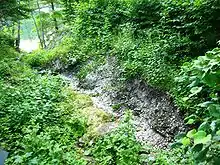
A shell midden or shell mound is an archaeological feature consisting mainly of mollusc shells. The Danish term køkkenmøddinger (plural) was first used by Japetus Steenstrup to describe shell heaps and continues to be used by some researchers. A midden, by definition, contains the debris of human activity, and should not be confused with wind- or tide-created beach mounds. Some shell middens are processing remains: areas where aquatic resources were processed directly after harvest and prior to use or storage in a distant location.
Some shell middens are directly associated with villages, as a designated village dump site. In other middens, the material is directly associated with a house in the village. Each household would dump its garbage directly outside the house. In all cases, shell middens are extremely complex and very difficult to excavate fully and exactly. The fact that they contain a detailed record of what food was eaten or processed and many fragments of stone tools and household goods makes them invaluable objects of archaeological study.
Shells have a high calcium carbonate content, which tends to make the middens alkaline. This slows the normal rate of decay caused by soil acidity, leaving a relatively high proportion of organic material (food remnants, organic tools, clothing, human remains) available for archaeologists to find.[3]
Edward Sylvester Morse conducted one of the first archaeological excavations of the Omori Shell Mounds in Tokyo, Japan in 1877, which led to the discovery of a style of pottery described as "cord-marked", translated as "Jōmon", which came to be used to refer to the early period of Japanese history when this style of pottery was produced.[4][5] Shell middens were studied in Denmark in the latter half of the 19th century. The Danish word køkkenmødding (kitchen mound) is now used internationally. The English word "midden" (waste mound) derives from the same Old Norse word that produced the modern Danish one.[6]
Examples
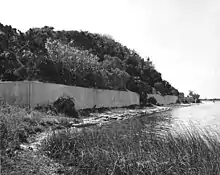
Shell middens are found in coastal or lakeshore zones all over the world. Consisting mostly of mollusc shells, they are interpreted as being the waste products of meals eaten by nomadic groups or hunting parties. Some are small examples relating to meals had by a handful of individuals, others are many metres in length and width and represent centuries of shell deposition. In Brazil, they are known as sambaquis, having been created over a long period between the 6th millennium BCE and the beginning of European colonisation.
European shell middens are primarily found along the Atlantic seaboard and in Denmark and primarily date to the 5th millennium BCE (Ertebølle and Early Funnel Beaker cultures), containing the remains of the earliest Neolithisation process (pottery, cereals and domestic animals). Younger shell middens are found in Latvia (associated with Comb Ware ceramics), Sweden (associated with Pitted Ware ceramics), the Netherlands (associated with Corded Ware ceramics) and Schleswig-Holstein (Late Neolithic and Iron Age). All these are examples where communities practised a mixed farming and hunting/gathering economy.
On Canada's west coast, there are shell middens that run for more than 1 kilometre (0.6 mi) along the coast and are several meters deep.[7] The midden in Namu, British Columbia is over 9 metres (30 ft) deep and spans over 10,000 years of continuous occupation.
Shell middens created in coastal regions of Australia by Indigenous Australians exist in Australia today. Middens provide evidence of prior occupation and are generally protected from mining and other developments. One must exercise caution in deciding whether one is examining a midden or a beach mound. There are good examples on the Freycinet Peninsula in Tasmania where wave action currently is combining charcoal from forest fire debris with a mix of shells into masses that storms deposit above high-water mark. Shell mounds near Weipa in far north Queensland that are mostly less than 2 metres (6.6 ft) high (although ranging up to 10 metres (33 ft) high) and a few tens of metres long are claimed to be middens,[8] but are in fact shell cheniers (beach ridges) re-worked by nest mound-building birds.[9] Some shell middens are regarded as sacred sites, linked to the Dreamtime, such as those of the Anbarra group of the Burarra people of Arnhem Land.[10]
Shell mounds are also credited with the creation of tropical hardwood hammocks, one example being the Otter Mound Preserve in Florida, where shell deposits from Calusa natives provided flood free high areas in otherwise large watered areas.[11]
There are instances in which shell middens may have doubled as areas of ceremonial construction or ritual significance. The Woodland period Crystal River site provides an example of this phenomenon.[12]
Some shell mounds, known as shell rings, are circular or open arcs with a clear central area. Many are known from Japan and the southeastern United States, and at least one from South America.[13]
Middens in Taiwan
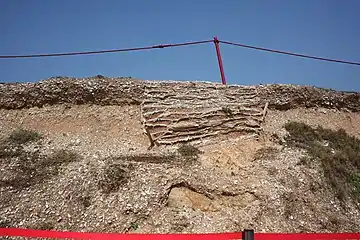
Middens in Taiwan are mostly presented as a pile of seashells. The presence of shell middens indicates a subsistence relying on aquatic resources.
In addition to large amounts of seashells, discarded pottery sherds, stone tools, animal bones, and fish bones were also often found in middens. Middens are distributed from northern to southern Taiwan, as well as outlying islands. Archaeological cultures that have been discovered to have middens include Tahu Culture and Niaosung Culture in southern Taiwan; Fantzuyuan Culture in central Taiwan; Shihsanhang Culture and Yuanshan Culture in northern Taiwan;[14] and the Liang Tao Tao Wei (LTTW) Archaeological Site on Liang island, Beigan Township, Lienchiang County (the Matsu Islands) also found shell middens that can be dated back to 8,300 to 7,000 years ago (B.P.; or 6,351-5,051 BC)[15]
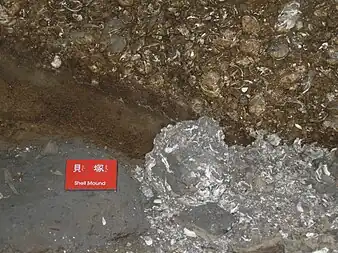
Middens in Yuanshan Culture are the most famous, so it is sometimes called “Midden Culture” as well. The thick deposits of midden in a large area had been found and investigated during the Japanese Colonial Period,[16] along with human bones.[16] Middens with human bones were also found at the Liang Tao Tao Wei (LTTW) Archaeological Site. The two skeletons unearthed at LTTW are well preserved. The establishment of nucleic acid sequences for the human bones collected at LTTW is one of the most significant discoveries in recent times.[15]
Middens contain rich calcium carbonate, which can effectively neutralize the acidity of the soil. The calcium carbonate mitigates the decomposition of human and animal bones, providing well-preserved research materials for archaeologists. Aside from indicating subsistence at the time, the seashells can also be analyzed to obtain information on diet preferences, harvest seasons, and environmental formations.[14]
Etymology and usage
The word is of Scandinavian via Middle English derivation (from early Scandinavian; Danish: mødding, Swedish regional: mödding).[17]
The word "midden" is still in everyday use in Scotland and has come by extension to refer to anything that is a mess, a muddle, or chaos.[18]
The word is used by farmers in Britain to describe the place where farm yard manure from cows or other animals is collected. Grants are sometimes available to protect these from rain to avoid runoff and pollution.[19][20]
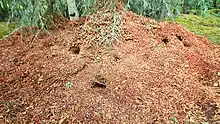
In the animal kingdom, some species establish ground burrows, also known as middens, that are used mostly for food storage. For example, the North American red squirrel (Tamiasciurus hudsonicus) usually has one large active midden in each territory with perhaps an inactive or auxiliary midden.[21] A midden may be a regularly used animal toilet area or dunghill, created by many mammals, such as the hyrax, and also serving as a territorial marker.[22]
Octopus middens are piles of debris that the octopus piles up to conceal the entrance of its den. Octopus middens are commonly made of rocks, shells, and the bones of prey, although they may contain anything the octopus finds that it can move.[23]
See also
- Asturian culture, characterized by shell-middens
- Crystal River Archaeological State Park
- Emeryville Shellmound
- Green Mound
- Landfill
- Mussel Point, a megamidden in the South African West Coast
- Packrat midden
- Privy midden
- Tell
- Tumulus
- Urban archaeology
- Waste management in Australia#Pre-European settlement
- West Berkeley Shellmound
- Whaleback Shell Midden
- Yachats, Oregon
References
- Brinton, DG (1866). "Artificial Shell-deposits of the United States". Reports. Washington: Smithsonian Institution.
- Stein, Julie (2000). Exploring Coast Salish Prehistory: The Archaeology of San Juan Island.
- "Whaleback Shell Midden". Retrieved 11 May 2006.
- John Whitney Hall (1988). The Cambridge History of Japan. Cambridge University Press. p. 59. ISBN 978-0-521-22352-2.
- Keiji Imamura. "Collections of Morse from The Shell Mounds of Omori". Digital Museum, University of Tokyo. Retrieved 4 September 2015.
- "Online Etymology Dictionary". www.etymonline.com.
- Stein, Julie (1992). Deciphering a Shell Midden. Academic Press. ISBN 978-0-12-664730-3.
- Bailey, Geoff; Chappell, John; Cribb, Roger (1994). "The Origin of 'Anadara' Shell Mounds at Weipa, North Queensland, Australia". Archaeology in Oceania. 29 (2): 69–80. doi:10.1002/arco.1994.29.2.69. JSTOR 40386985.
- Stone, Tim (31 December 1995). "Shell mound formation in coastal northern Australia". Marine Geology. 129 (1–2): 77–100. Bibcode:1995MGeol.129...77S. doi:10.1016/0025-3227(95)00101-8.
- Griffiths, Billy (2018). Deep Time Dreaming: Uncovering Ancient Australia. Black Inc. p. 164.
- "Otter Mound Preserve". Colliergov.net. Retrieved 24 February 2014.
- Pluckhahn, Thomas J.; Thompson, Victor D.; Cherkinsky, Alexander (2015). "The temporality of shell-bearing landscapes at Crystal River, Florida". Journal of Anthropological Anthropology. 37: 19–36. doi:10.1016/j.jaa.2014.10.004.
- Lawrence, David R. and Hilda L. Wrightson. "Late Archaic-Early Woodland Period Shell Rings of the Southeastern United States Coast: A Bibliographic Introduction". University of South Carolina. Retrieved 10 December 2011.
- 陳珮瑜 (Chen Pei-Yu) (9 September 2009). "貝塚". 臺灣大百科全書 (in Chinese (Taiwan)). 文化部. Retrieved 20 December 2022.
- "亮島島尾考古遺址". 國家文化資產網 (in Chinese (Taiwan)). Archived from the original on 27 November 2021. Retrieved 20 December 2022.
{{cite web}}: CS1 maint: unfit URL (link) - 曹銘宗; 張仁豪 (8 December 2000). "劉益昌:人骨出土 有助研究圓山文化墓葬". 聯合報 (in Chinese (Taiwan)). Retrieved 20 December 2022.
- Oxford English Dictionary (3rd ed.), 2003.
- "Annaker's midden n. a mess, a shambles". Scots Language Centre. Retrieved 15 July 2020.
- "Manure/Slurry Storage". Scottish Government.
Investment under this storage and handling Option may include: action to minimise the volume of clean water getting into manure or slurry stores, including the installation of covers for slurry storage facilities and middens
- "Roofed Midden benefits Lake District Farm".
Thanks to a grant from Farming Connect Cumbria the Booths were able to roof the slurry midden, probably trebling its capacity by excluding the rainwater, as well as making necessary repairs to the midden itself to prevent possible run-off to a nearby beck. The midden can now provide up to 10 weeks' storage for the slurry.
- dfg.webmaster@alaska.gov. "Alaska Department of Fish & Game: North American Red Squirrel". Adfg.state.ak.us. Retrieved 24 February 2014.
- Chase, B.M.; Meadows, M.E.; Scott, L.; Thomas, D.S.G.; Marais, E.; Sealy, J.; Reimer, P.J. (2009). "A record of rapid Holocene climate change preserved in hyrax middens from southwestern Africa". Geology. 37 (8): 703–6. Bibcode:2009Geo....37..703C. doi:10.1130/G30053A.1.
- Ambrose, Richard F. (1983). "Midden formation by octopuses: The role of biotic and abiotic factors". Marine Behaviour and Physiology. 10 (2): 137–144. doi:10.1080/10236248309378613.
Published online: 22 Jan 2009
External links
- Hidefumi Ogawa (小川英文). "The excavations of Lal-lo shell middens (in the Philippines)". Tokyo University of Foreign Studies. Retrieved 19 October 2008.